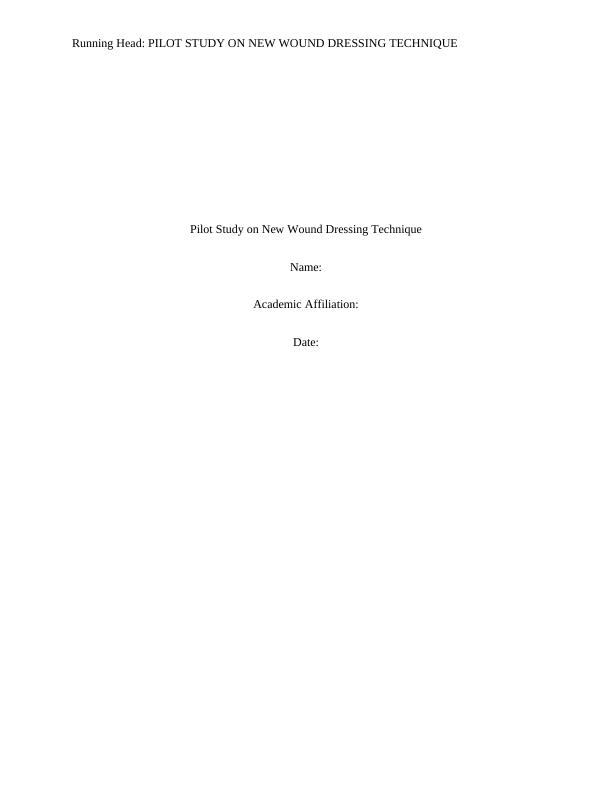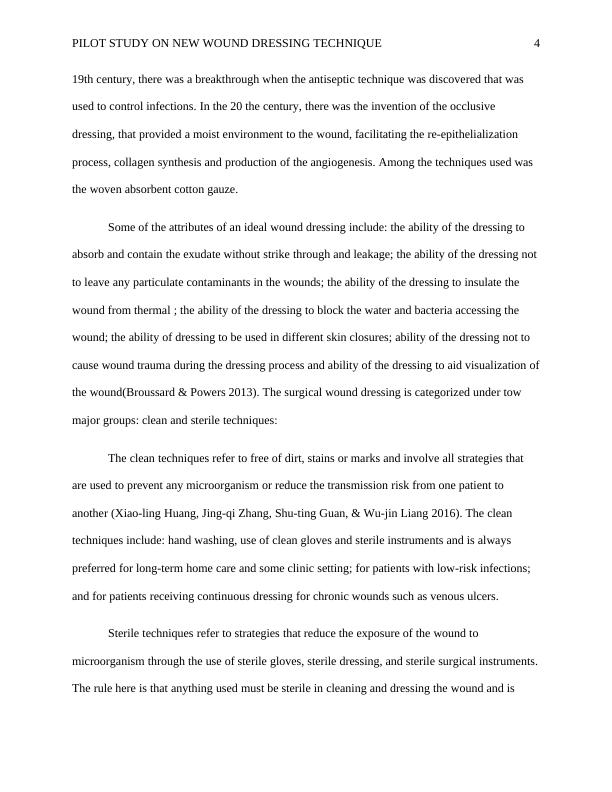Ask a question from expert
Pilot Study on New Wound Dressing Technique
20 Pages4940 Words60 Views
Added on 2021-10-01
Pilot Study on New Wound Dressing Technique
Added on 2021-10-01
BookmarkShareRelated Documents
Running Head: PILOT STUDY ON NEW WOUND DRESSING TECHNIQUE
Pilot Study on New Wound Dressing Technique
Name:
Academic Affiliation:
Date:
Pilot Study on New Wound Dressing Technique
Name:
Academic Affiliation:
Date:

PILOT STUDY ON NEW WOUND DRESSING TECHNIQUE 2
Part 1
Introduction
There are always millions of surgical procedures conducted around the world every year
that majority resulted in surgical wounds. Following the surgical wound closures, the wounds
always leak fluids within the first 24 hours as they are frequently covered with different types of
dressings such as glue-as- a-dressing aimed at providing the protection to the wound(Rodriguez-
Merchan 2012). Studies show that many surgical wounds receive poor dressing procedures
exposing the wounds to surgical sites infections that results in more complications and even to
deaths. Studies indicate that about seventy-seven per cent of the surgical patient deaths always
resulted from the infractions that are directly correlated to the open surgical wounds
(Vasconcelos & Cavaco-Paulo 2011). The Centers for Disease Control in the USA reported that
considerable advances have been made in the infection control practices such as sterilization
methods, using of advanced surgical techniques and antimicrobial prophylaxis, SSI is still a
significant cause of morbidity and prolonged hospitalization even deaths. Thus the recognition of
the best surgical dressing is the most important issues to address the issue.
Search strategy
The evidence of the study will be retrieved from various databases such as MEDLINE,
CIN NL, and Scopus databases systems. Other sources of the evidence search will be Google
Scholars that will be used to receive the literature on the topic under the study. Therefore, using
the search terminologies such as ‘surgical wound’ and ‘wound dressing techniques’, the
researcher came across 30 peer-reviewed journals and research papers that were between 2011
Part 1
Introduction
There are always millions of surgical procedures conducted around the world every year
that majority resulted in surgical wounds. Following the surgical wound closures, the wounds
always leak fluids within the first 24 hours as they are frequently covered with different types of
dressings such as glue-as- a-dressing aimed at providing the protection to the wound(Rodriguez-
Merchan 2012). Studies show that many surgical wounds receive poor dressing procedures
exposing the wounds to surgical sites infections that results in more complications and even to
deaths. Studies indicate that about seventy-seven per cent of the surgical patient deaths always
resulted from the infractions that are directly correlated to the open surgical wounds
(Vasconcelos & Cavaco-Paulo 2011). The Centers for Disease Control in the USA reported that
considerable advances have been made in the infection control practices such as sterilization
methods, using of advanced surgical techniques and antimicrobial prophylaxis, SSI is still a
significant cause of morbidity and prolonged hospitalization even deaths. Thus the recognition of
the best surgical dressing is the most important issues to address the issue.
Search strategy
The evidence of the study will be retrieved from various databases such as MEDLINE,
CIN NL, and Scopus databases systems. Other sources of the evidence search will be Google
Scholars that will be used to receive the literature on the topic under the study. Therefore, using
the search terminologies such as ‘surgical wound’ and ‘wound dressing techniques’, the
researcher came across 30 peer-reviewed journals and research papers that were between 2011

PILOT STUDY ON NEW WOUND DRESSING TECHNIQUE 3
and 2018. Applying the search criteria, the researcher found 20 that met the criteria for the
literature review and the pilot study.
Literature Review
Surgical wound refers to the cut made at the skin by the surgeon during the operation and
at the end, the cut is always joined back together through the use of stitches, strips or adhesive
dressings to allow the skin edges to come together and heal (Percival, Mayer & Salisbury 2017).
There are 2 major types of wounds following surgery: incisional wounds and excisional
wounds. , therefore, after every surgery, the choices of dressing facilitate the healing process of
the wound. The incisional wounds are made when the cutting goes through the skin, muscles and
fat so that the body part can be repaired or removed. On the other hand, the excisional wounds
are made when the surgeon wants to remove a cyst or any other types of tissues.
The dressing is a sterile pad applied on the wound majorly to absorb any leakage from the
wound, provide ideal conditions for healing, protect the wound until it is healed and prevent the
stitches from catching on cloth. The dressings are designed to be in contact with the wound thus
needs to be effective to prevent further infection and facilitate healing (Green 2013). When the
wounds are closed with appropriate dressing, they are continuously exposed to the protease,
complement, chemotactic and growth factors.
History of the wound dressing
Historically, people used wet-to-dry dressing methods that required debridement. During
the 1600 BC, Linen strips were soaked in either oil or grease and then covered with plasters and
used to occlude the wounds. In other societies, the wounds were cleaned using milk and water
prior to dressing with honey (Arslan, Murat, Aldemir, Kazaro & Gümü-derelio 2014). In the
and 2018. Applying the search criteria, the researcher found 20 that met the criteria for the
literature review and the pilot study.
Literature Review
Surgical wound refers to the cut made at the skin by the surgeon during the operation and
at the end, the cut is always joined back together through the use of stitches, strips or adhesive
dressings to allow the skin edges to come together and heal (Percival, Mayer & Salisbury 2017).
There are 2 major types of wounds following surgery: incisional wounds and excisional
wounds. , therefore, after every surgery, the choices of dressing facilitate the healing process of
the wound. The incisional wounds are made when the cutting goes through the skin, muscles and
fat so that the body part can be repaired or removed. On the other hand, the excisional wounds
are made when the surgeon wants to remove a cyst or any other types of tissues.
The dressing is a sterile pad applied on the wound majorly to absorb any leakage from the
wound, provide ideal conditions for healing, protect the wound until it is healed and prevent the
stitches from catching on cloth. The dressings are designed to be in contact with the wound thus
needs to be effective to prevent further infection and facilitate healing (Green 2013). When the
wounds are closed with appropriate dressing, they are continuously exposed to the protease,
complement, chemotactic and growth factors.
History of the wound dressing
Historically, people used wet-to-dry dressing methods that required debridement. During
the 1600 BC, Linen strips were soaked in either oil or grease and then covered with plasters and
used to occlude the wounds. In other societies, the wounds were cleaned using milk and water
prior to dressing with honey (Arslan, Murat, Aldemir, Kazaro & Gümü-derelio 2014). In the

PILOT STUDY ON NEW WOUND DRESSING TECHNIQUE 4
19th century, there was a breakthrough when the antiseptic technique was discovered that was
used to control infections. In the 20 the century, there was the invention of the occlusive
dressing, that provided a moist environment to the wound, facilitating the re-epithelialization
process, collagen synthesis and production of the angiogenesis. Among the techniques used was
the woven absorbent cotton gauze.
Some of the attributes of an ideal wound dressing include: the ability of the dressing to
absorb and contain the exudate without strike through and leakage; the ability of the dressing not
to leave any particulate contaminants in the wounds; the ability of the dressing to insulate the
wound from thermal ; the ability of the dressing to block the water and bacteria accessing the
wound; the ability of dressing to be used in different skin closures; ability of the dressing not to
cause wound trauma during the dressing process and ability of the dressing to aid visualization of
the wound(Broussard & Powers 2013). The surgical wound dressing is categorized under tow
major groups: clean and sterile techniques:
The clean techniques refer to free of dirt, stains or marks and involve all strategies that
are used to prevent any microorganism or reduce the transmission risk from one patient to
another (Xiao-ling Huang, Jing-qi Zhang, Shu-ting Guan, & Wu-jin Liang 2016). The clean
techniques include: hand washing, use of clean gloves and sterile instruments and is always
preferred for long-term home care and some clinic setting; for patients with low-risk infections;
and for patients receiving continuous dressing for chronic wounds such as venous ulcers.
Sterile techniques refer to strategies that reduce the exposure of the wound to
microorganism through the use of sterile gloves, sterile dressing, and sterile surgical instruments.
The rule here is that anything used must be sterile in cleaning and dressing the wound and is
19th century, there was a breakthrough when the antiseptic technique was discovered that was
used to control infections. In the 20 the century, there was the invention of the occlusive
dressing, that provided a moist environment to the wound, facilitating the re-epithelialization
process, collagen synthesis and production of the angiogenesis. Among the techniques used was
the woven absorbent cotton gauze.
Some of the attributes of an ideal wound dressing include: the ability of the dressing to
absorb and contain the exudate without strike through and leakage; the ability of the dressing not
to leave any particulate contaminants in the wounds; the ability of the dressing to insulate the
wound from thermal ; the ability of the dressing to block the water and bacteria accessing the
wound; the ability of dressing to be used in different skin closures; ability of the dressing not to
cause wound trauma during the dressing process and ability of the dressing to aid visualization of
the wound(Broussard & Powers 2013). The surgical wound dressing is categorized under tow
major groups: clean and sterile techniques:
The clean techniques refer to free of dirt, stains or marks and involve all strategies that
are used to prevent any microorganism or reduce the transmission risk from one patient to
another (Xiao-ling Huang, Jing-qi Zhang, Shu-ting Guan, & Wu-jin Liang 2016). The clean
techniques include: hand washing, use of clean gloves and sterile instruments and is always
preferred for long-term home care and some clinic setting; for patients with low-risk infections;
and for patients receiving continuous dressing for chronic wounds such as venous ulcers.
Sterile techniques refer to strategies that reduce the exposure of the wound to
microorganism through the use of sterile gloves, sterile dressing, and sterile surgical instruments.
The rule here is that anything used must be sterile in cleaning and dressing the wound and is

End of preview
Want to access all the pages? Upload your documents or become a member.
Related Documents
The Impact of Clean and Sterile Dressing Techniques on Wound Infection Incidencelg...
|10
|1883
|27
Principles of Wound Management in the Clinical Environmentlg...
|13
|4152
|1
Wound Management | Nursing Assignmentlg...
|12
|1829
|21
Comparison of Skin Closure Methods in Laparoscopic Surgerylg...
|56
|16858
|167